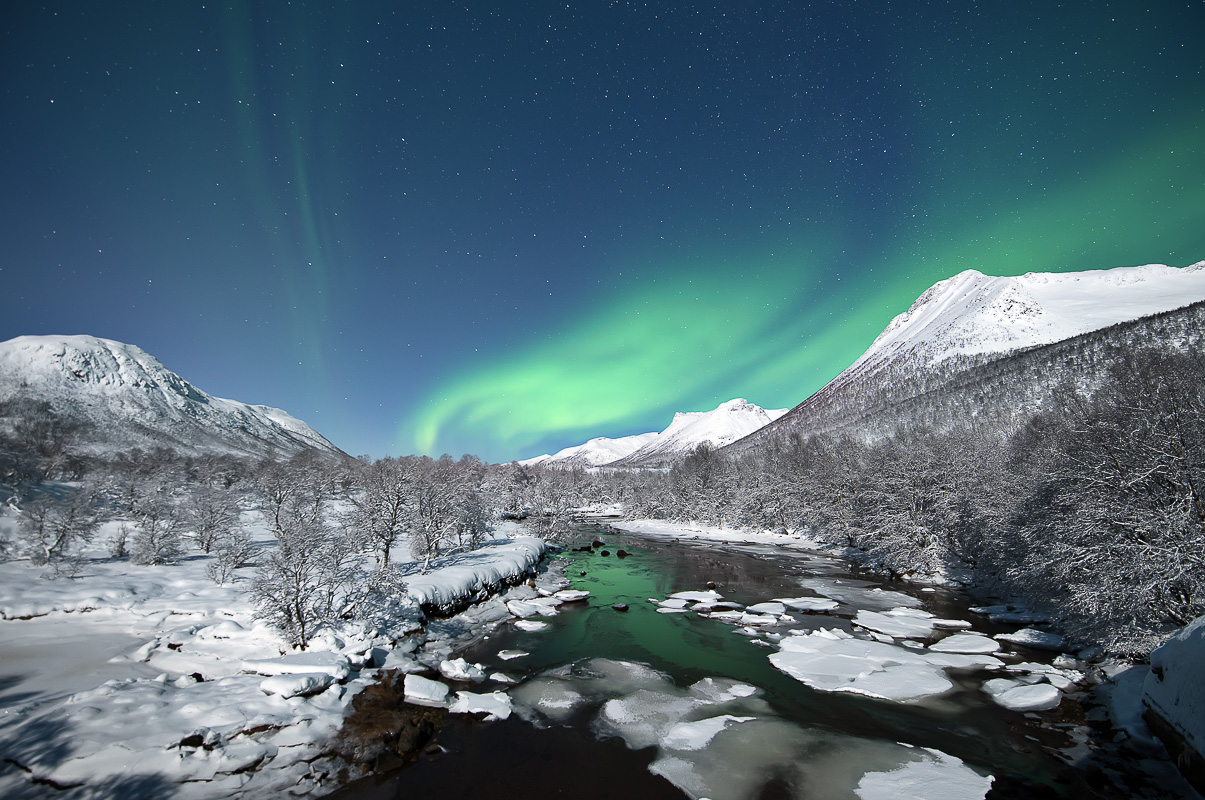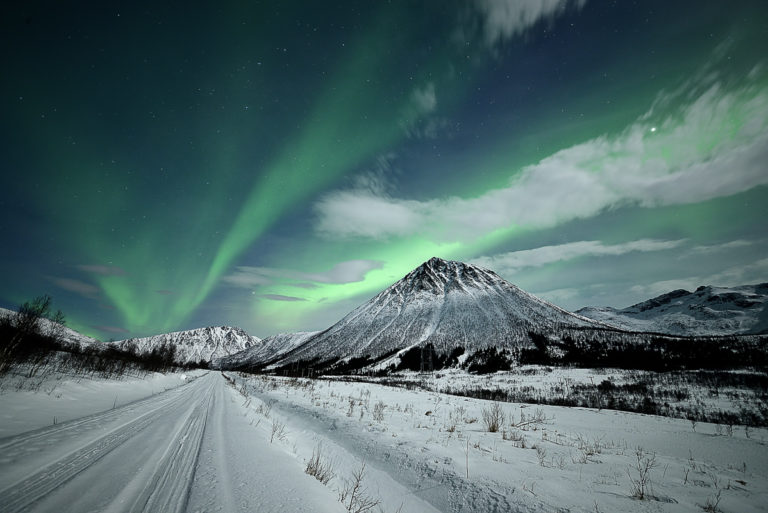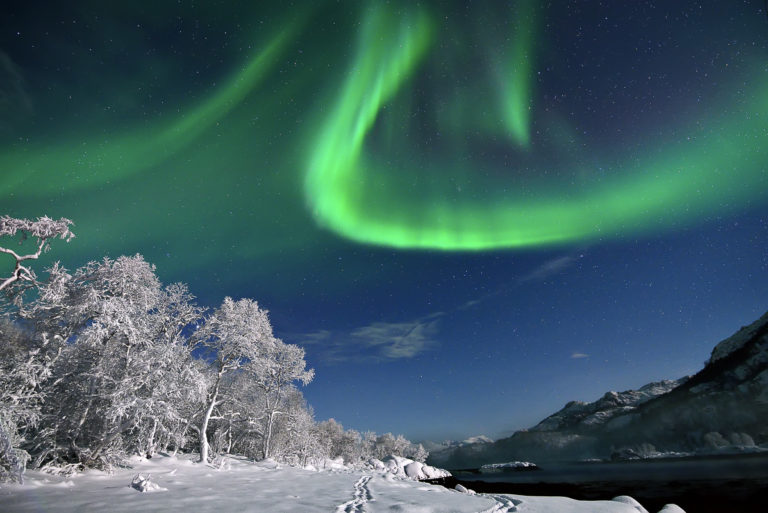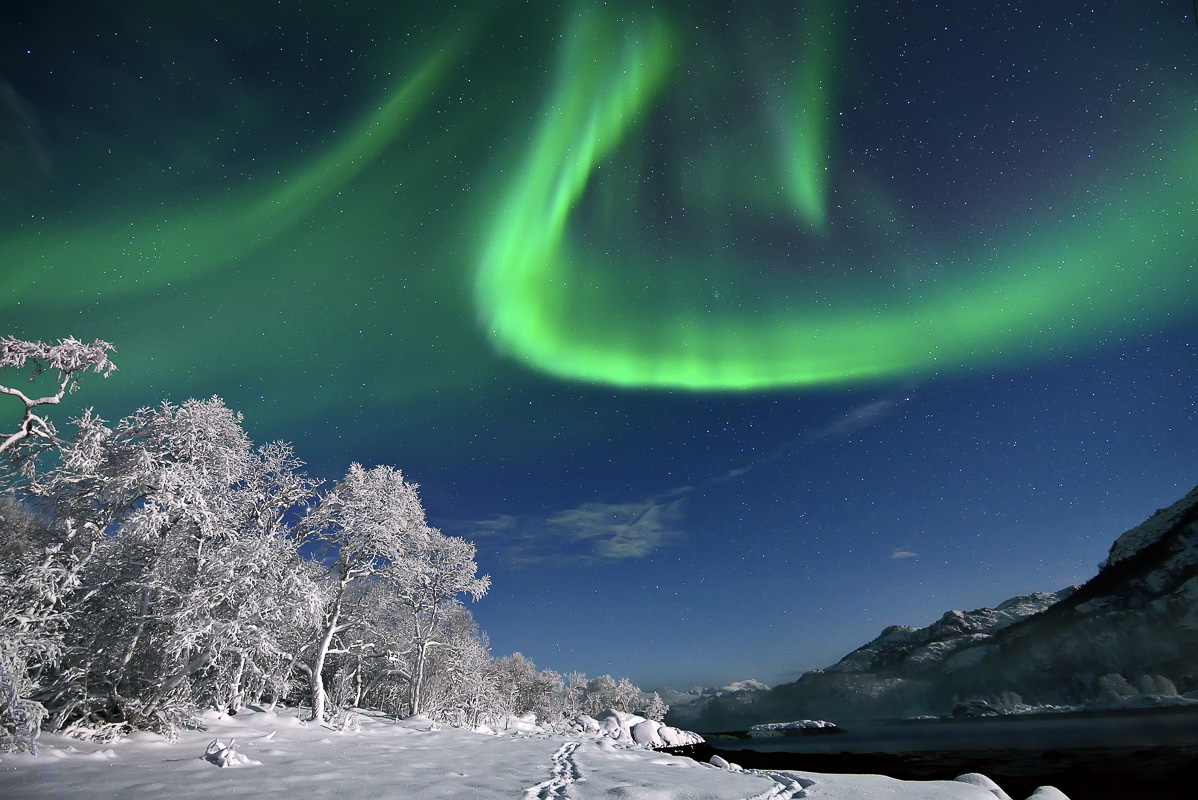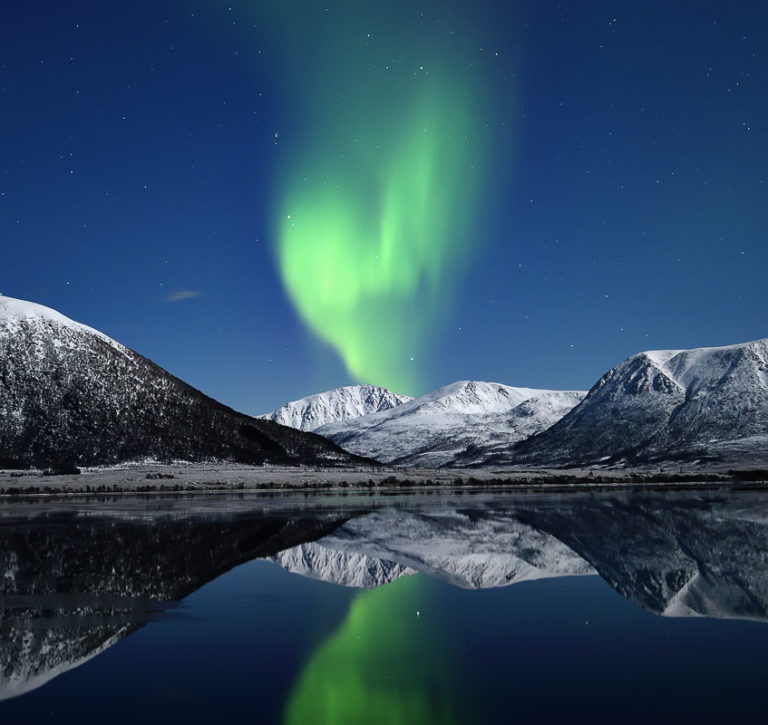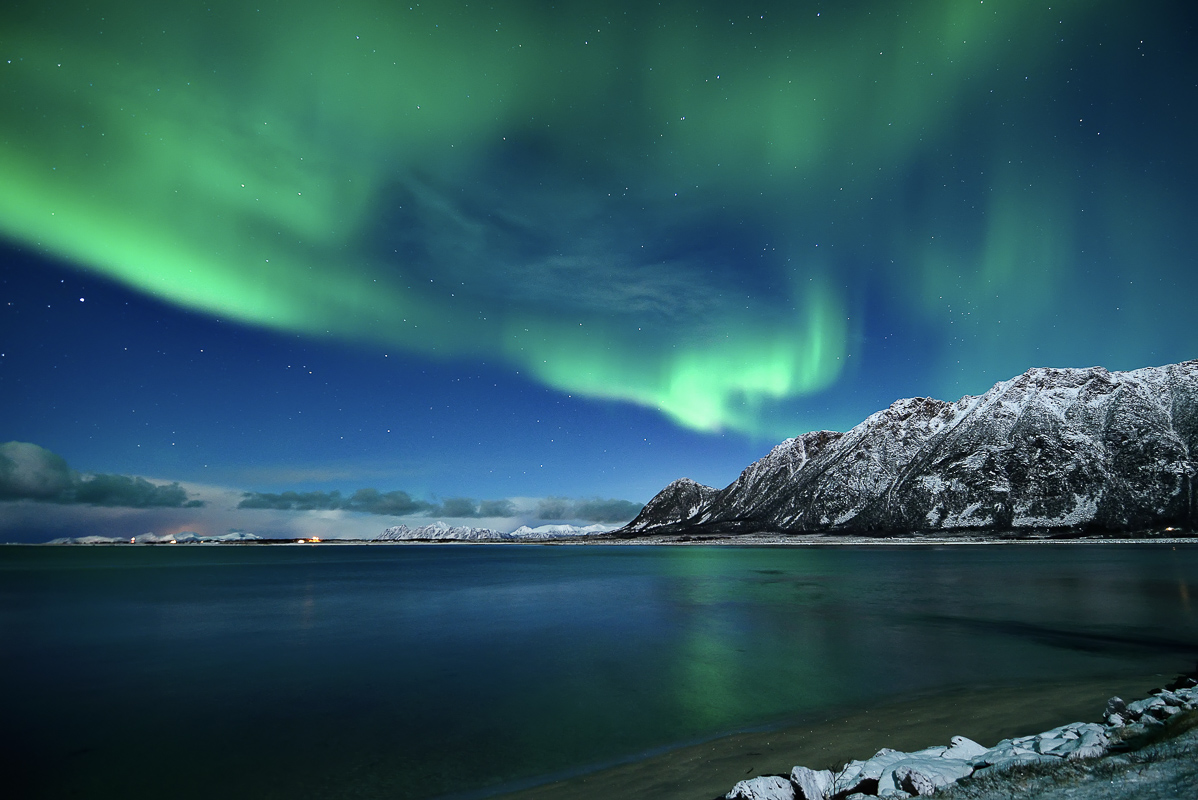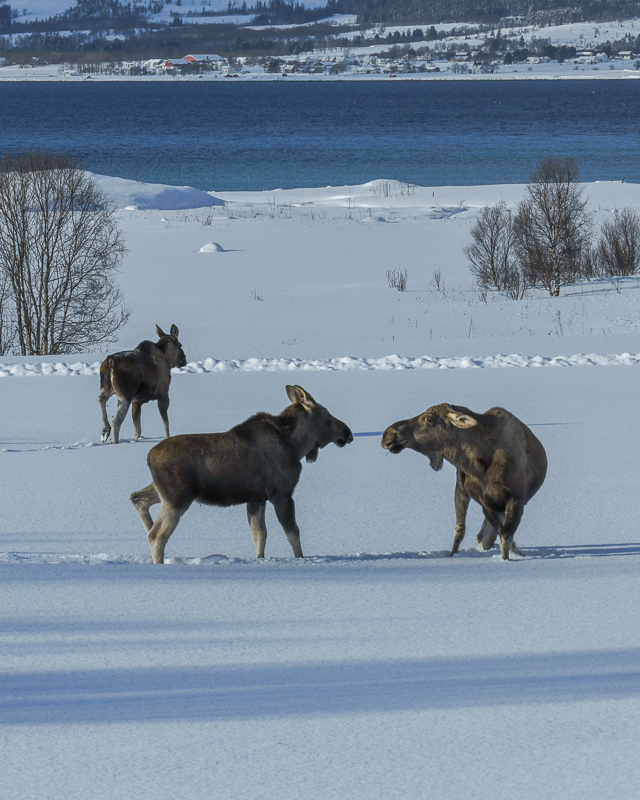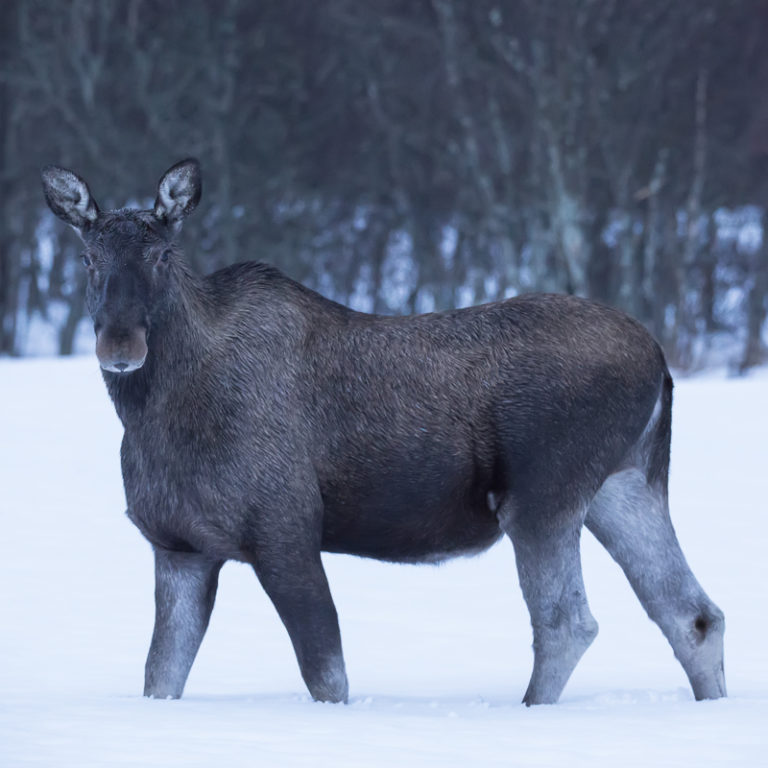Two photographers working together have managed to put the archipelago of Vesterålen firmly on the map for the advanced Northern Lights seeker. They did by simply taking fantastic photos.
Crisp, clear photographs seem to jump out of your mobile phone screen. Aurora is dancing in her green attire over magically clear, moonlit winter night landscapes. The photos of second cousins Jens and Marius Birkeland are simply stunning. They make an archipelago engulfed in winter and darkness look dreamy and otherworldly. One can join them on their tours, or just admire the photographs. Or explore their home turf of Vesterålen on your own.
The 2003 Halloween Solar Storm was the turning point
We had a chat with Marius, who got hitched by the 2003 Halloween solar storm. Since then, he and his relative have spent countless hours out in the snow looking for more. Aurora has been playing trick or treat with them many a time, but over the years they have learned all her secrets. Almost. The Halloween solar storm was the biggest this century, but Marius is always hoping for a storm to match what happened then.
In Vesterålen you see the Northern Lights when the apps say go to bed
The Northern Lights oval, the oval shaped zone some 2500 km around the magnetic North Pole where the Northern Lights are most frequent, passes above our heads in Vesterålen. The word Kp index often comes up when discussing the Northern Lights. The Kp index indicates how far away from the Northern Lights oval one sees the Northern Lights. Vesterålen is right under the Northern Lights, so even with Kp0, it is possible to see big eruptions of Northern Lights. “The apps are not always right” Marius says, “and especially not directly under the oval where we are”. In Vesterålen, one can simply ignore the Kp index.
How badly do you want to see the Northern Lights?
Not everybody is ready for a long evening’s hunt, according to Marius. Some guests would only like to explore the winter night, with the Northern Lights as a bonus. “There is so much fun we can do” says Marius. He sometimes makes fires for grilling sausages, people try their luck at ice fishing, in the autumn one can go for a little mountain hike, they can look for moose and there are lovely viewpoints out along the outer coast. “As long as we’re out under the open sky, we’re in a good position to see the lights” Marius says.
A pro also needs a Northern Lights guide
There are, however, seasoned Northern Lights photographers who also need assistance. The photographer that has already seen the Northern Lights but would like to shoot it in a different setting, could consult Vesterålen Tours. On a clear night, Jens and Marius can lead the way to the Northern Lights in different conditions; in flat terrain to have maximum views of a solar storm, or Northern Light beams streaming like rivers over majestic peaks. Marius and Jens know a plethora of locations all over the islands.
A full moon is a great help
“You don’t see the Northern Lights when there is a full moon” we often get to hear – Marius says. Marius is of the opposite opinion. You get to see more of the landscape when there is a full moon. It is also easier to adjust the camera, and you can have a shorter shutter speed. This, again, means you more easily see the lines in the Northern Lights. “Don’t let the full moon stop you” Marius says “we take some of our best photos then”.
What are the ideal conditions?
Sometimes the conditions are ideal, and Marius can take what he considers his dream photo, here is his example, in his own words:
Sometimes you imagine how a photo can look really good if the conditions are right. And you plan it in your head over several years. This photo from Forfjord is a good example. Here I envisioned it in absolute calm after a snow fall, and Northern Lights erupting with the tide coming in. It would then be possible to get a photo with snowclad rocks in the foreground matching the mountain in the back. In addition, I imagined the full moon from behind to lit up the landscape, and the Northern Lights to mirror in the sea. One evening I was lucky to capture it all on my memory card. The weak Northern Lights allowed me a longer shutter speed without burning out the Northern Lights as well.

Animal photography goes well with Northern Lights photography
Another passion for the small photo company is portraying the wildlife. When the snow is knee deep, it’s easy to see where the moose is moving. Marius and Jens often see moose moving about during the day, so they are easy to find at night. Reindeer are also plentiful in the area. Foxes are all over the place, but they are more difficult to catch on camera. However, one can film them and make little videos.
The weather chart is studied carefully
Part of the company’s work is to check the weather chart carefully before heading out. What is the wind direction, where do the clouds come in? If a high pressure from the south east reigns, you can go wherever you like. But dense clouds, rain or snow means you must plan well. “Sometimes we don’t know where to go even when we meet the guests” Marius says, “It just has to be decided on the spot”. Being a Northern Lights guide thus means you must be able both to plan and to improvise.
Sometimes the outer coast is the best place
If the clouds are low, the outer coasts sometimes sport clear skies. Then they head for the long beaches and open stretches along the Norwegian Scenic Route on Andøya Island. It’s just magical to hear the swell out there, see the stars and wait for the lights to happen. Another favourite is at Bø, with its rocky beaches and headlands and compact settlements facing the open ocean.
The crazy geography of Hinnøya Island hides clear skies on difficult days
But what happens if the weather is horrible? When autumn rain weathers come in, the cloud cover is dense, and everything feels hopeless? Then the experienced chasers head for the wildest area of Vesterålen, its mountainous south-eastern corner. Here, the mountains tower up to 1262 metres, fjords go in western, southern, and northern directions and the weather can be very different within a very short distance. In this maze-like landscape, you can almost always find respite from the bad weather. Winding country roads lead to rain shadow settlements few know about. But Marius has spent many a night looking for starry skies from the car window, and usually finds them.
Vesterålen enjoys a mild climate – but Marius sometimes looks for the cold
There is less freezing involved in Northern Lights watching in Vesterålen than elsewhere, as Vesterålen’s winter temperatures are lessened by the tepid waters of the Golf Stream. “But a few degrees below can feel pretty cold here”, Marius admits. Sometimes, though, Marius really wants it to be cold. To achieve the clear photos that are their trademark, the cold can be helpful. When it is -20 C at the Vikseidet crossing – as much “inland” you can get in an island, the air gets very clear. All the humidity in the air simply vanishes, and the snowy landscape takes on a fairy tale hue.
Northern Lights in Vesterålen is for the adventurous
In Vesterålen, Northern Lights tourists don’t leave the hotels by the busloads. “The adventurous come here” Marius says, “and the ones seeking peace and quiet”. Vesterålen has nice and comfortable hotels, but none of the big chains are represented. There are also small holiday villages, holiday houses and guesthouses spread around the settlements. Most of the accommodation is found where people live, in smaller and larger villages. “Go with us on one of your evenings here, and search for yourself the others” Marius suggests.
Have a relaxed day programme
The Vesterålen Islands are relatively concentrated and offer a lot within a short distance. The outer coast is rocky and picturesque, inviting to walks in the middle of winter. The snow situation is highly unstable out here, so a mountain hike is possible both in autumn and in the early part of winter. Further inland, the snow lies deep through most of the winter, and one can do cross-country skiing, snowshoeing and off-piste skiing, and companies offer dogsledding.
There is plenty to see
A narrow, winding road leads to the once abandoned fishing village of Nyksund, that has got a new lease of life with the help of alternative forces. The Norwegian Scenic Route at Andøy Island has long, sandy beaches, rocks, and pebbles and unobstructed seaview. At Spaceship Aurora, you can get the full explanation of the aurora. The small town of Andenes at its end has the iconic lighthouse, a picturesque port, and a chance to go out and see whales. The biggest town in the archipelago, Sortland, is known for its blue colour. Most houses are painted blue, which looks cool both from a distance and when you walk around. At Stokmarknes, you can visit the new museum for the Hurtigruten line, with the proud ship of “Finnmarken” in a state-of-the-art glass casing. “The man from the sea” – the sculpture in Bø, is a photographer’s delight.
Eating well is important before the hunt
There is also good dining in Vesterålen. In January, the Norwegian-arctic cod spawns just off the western coast of the islands. The very rustic dish “mølja”, cod with liver and roe, is served everywhere to a very skilled and critical local audience. At the other end of the poshness scale, we find the new gourmet shooting star of Kvitnes gård in remote Kvitnes. Expeditionen in Nyksund and Arresten in an old prison in Andenes are also worth a detour. Marius also talks warmly of Andøy friluftssenter in the hamlet of Buksnesfjord.
